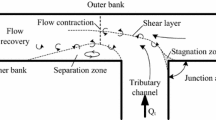Abstract
In water supply channels, the brusque operation of control gates may induce large unsteady flow motion called surges. Such a rapid operation of gates must often be restricted, although it may be conducted to scour silted channels and sewers. Herein a physical study was conducted under controlled flow conditions to study the turbulent mixing in the very-close vicinity of a rapidly opening/closing Tainter gate, with a focus on the unsteady transient mixing induced by the gate operation. The data suggested that the negative/positive surge generation was associated with large instantaneous free-surface fluctuations. The velocity measurements indicated significant variations in longitudinal velocity during the surge generation, as well as large fluctuations of all velocity components. The processes were associated with large Reynolds stress levels. A succession of rapid closure and opening of undershoot gates provided optimum conditions to scour silted canals, and the present results gave some detailed insights into the physical processes.









Similar content being viewed by others
References
Metzler DE (1948) A model study of Tainter-gate operation. M.Sc. Thesis, University of Iowa, Dept of Mechanics and Hydraulics, August, 22 pages
Lewin J (1985) Hydraulic gates and valves in free surface flow and submerged outlets. Thomas Telford, London, p 238
Henderson FM (1966) Open channel flow. MacMillan Company, New York
Montes JS (1997) Irrotational flow and real fluid effects under planar sluice gates. J Hydrau Eng, ASCE 123(3):219–232
Liggett JA (1994) Fluid mechanics. McGraw-Hill, New York
Sturm TW (2001) Open channel hydraulics., Water resources and environmental engineering seriesMcGraw Hill, Boston, p 493
Chanson H (2004) Environmental hydraulics of open channel flows. Elsevier-Butterworth-Heinemann, Oxford, p 483
Reichstetter M (2011) Hydraulic modelling of unsteady open channel flow: physical and analytical validation of numerical models of positive and negative surges. MPhil thesis, School of Civil Engineering, The University of Queensland, Brisbane, p 112
Simon B, Chanson H (2013) Turbulence measurements in tidal bore-like positive surges over a rough bed. Hydraulic Model Report No. CH90/12, School of Civil Engineering, The University of Queensland, Brisbane, p 176
Montes JS (1998) Hydraulics of open channel flow. ASCE Press, New-York, p 697
Cunge J, Holly FM, Verwey A (1980) Practical aspects of computational river hydraulics. Boston, Pitman, p 420
Chaudhry MH (2008) Open channel flow, 2nd edn. Springer, New York
Riochet B (2008) La Sédimentation dans les Réseaux Unitaires Visitables: le Point de Vue d’un Exploitant. (‘Sedimentation in Large Combined Sewage Systems: Perspectives of an Operator.’) In: Bouguenais, Larrarte F, Chanson H (eds) Proceedings international meeting on measurements and hydraulics of sewers IMMHS’08, Summer School GEMCEA/LCPC, 19–21 Aug. 2008, Hydraulic Model Report No. CH70/08, Univ. of Queensland, Brisbane, pp 11–19 (in French)
Williams KJ, Tait SJ, Ashley RM (2009) In-sewer sedimentation associated with active flow control. Water Sci Technol 60(1):55–63
Chanson H, Wang H (2013) Unsteady discharge calibration of a large V-notch weir. Flow Meas Instrum 29:19–24. doi:10.1016/j.flowmeasinst.2012.10.010
Microsonic (2009) Instruction manual: mic + ultrasonic sensors with one analogue output. Microsonic GmbH, Dortmund, p 3
Nortek (2009) Vectrino velocimeter user guide. Nortek AS, Norway, p 42
Chanson H, Docherty NJ (2012) Turbulent velocity measurements in open channel bores. Eur J Mech B/Fluids 32:52–58. doi:10.1016/j.euromechflu.2011.10.001
Reichstetter M, Chanson H (2013) Negative surges in open channels: physical and numerical modeling. J Hydraul Eng ASCE 139(3):341–346. doi:10.1061/(ASCE)HY.1943-7900.0000674
Leng X, Chanson H (2015) Negative surges and unsteady turbulent mixing induced by rapid gate opening in a channel. Exp Therm Fluid Sci 63:133–143. doi:10.1016/j.expthermflusci.2014.06.015
Lubin P, Chanson H, Glockner S (2010) Large eddy simulation of turbulence generated by a weak breaking tidal bore. Environ Fluid Mech 10(5):587–602. doi:10.1007/s10652-009-9165-0
Spiegel MR (1972) Theory and problems of statistics. McGraw-Hill Inc., New York
Graf WH (1971) Hydraulics of sediment transport. McGraw-Hill, New York
Sanchez M, Levacher D (2008) Erosion d’une vase de l’estuaire de la Loire sous l’action du courant (Erosion of a mud from the Loire estuary by a flow). Bull Eng Geol Environ 67:597–605. doi:10.1007/s10064-008-0159-9
Jacobs W, Le Hir P, Van Kesteren W, Cann P (2011) Erosion threshold of sand–mud mixtures. Cont Shelf Res 31(10):S14–S25. doi:10.1016/j.csr.2010.05.012
Acknowledgments
The authors thank the reviewers for the helpful comments. They acknowledge the technical assistance of Jason Van Der Gevel and Matthew Stewart, School of Civil Engineering at the University of Queensland. The financial support of the Australian Research Council (Grant DP120100481) is acknowledged.
Author information
Authors and Affiliations
Corresponding author
Rights and permissions
About this article
Cite this article
Sun, S., Leng, X. & Chanson, H. Rapid operation of a Tainter gate: generation process and initial upstream surge motion. Environ Fluid Mech 16, 87–100 (2016). https://doi.org/10.1007/s10652-015-9414-3
Received:
Accepted:
Published:
Issue Date:
DOI: https://doi.org/10.1007/s10652-015-9414-3



